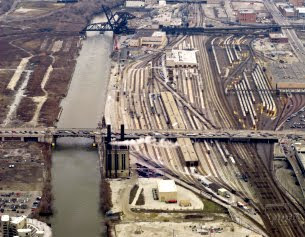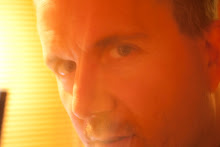
011- I read somewhere that people who write blogs pontificate about things they know very little about. I know very little about sound. Here’s my blog.
When I was a baby my mother and father lived in a small apartment that lived right behind the Chicago stockyards. Every night these trains would get slammed together and roll out before dawn. Y’know the song? “Ridin’ on the City of New Orleans…Illinois central Monday morning rail…”. Yup, those stock yards. Huge areas devoted to managing freight trains. We’re talking a lot of noise. Constant noise. And I slept through it all. Dad always said that’s why today I could sleep through anything.
I like to talk a lot about audio to anyone within earshot (get it? – A pun!) . For me, and I know I’ve said this already, editing picture is 50% about sound. Which is odd given our need for equipment that frequently goes “whirrrrrrr”. Or perhaps you didn’t notice.
You didn’t notice, or rather you STOPPED noticing, because your brain has a great way of tuning that crap out. If it didn’t people could never live in modern cities. Florescent buzz, exhaust fans, car engines, planes, trains, you-name-it constantly surrounds us. The brain makes it all go away so you can concentrate, focus if you will, on what’s important.
Back to picture for a moment. You know how your eyes compensate for different temperatures of light but cameras can’t do this so well -- so sometimes to get a bad colour cast to footage because the colour balance was set incorrectly? Well, location sound recordings are the same way. They do a very bad job of filtering noise. In fact they usually try hard to accentuate it.
That’s why sound mixers frequently work so hard to get rid of all that noise. They have filters and compressors and all sorts of newfangled plug-ins designed to clean all that up. And a lot of the time it is a good idea, especially if the voices you’re trying to hear are unintelligible due to noise.
But sometimes they do all that filtering and it turns out sounding bad. You see many sound mixers, even “the best” ones, feel that the best possible world is a soundscape which is pristine. Where voices emanate from a noiseless atmosphere. And, frankly, it just never sounds right.
Whenever I want to do any kind of ADR (additional dialogue recording) to replace an actor in a scene I usually drag them outside, not in a studio. Why? Well because the world we live in isn’t perfect. And the way a voice interacts with that world has a particular sound signature that makes it sound real. Outside is dramatically different from inside. When ADR work is done in studio it sounds…well… wrong. The sound gets too clean. Nature isn’t like that. And adding any reverb or sound in later isn’t the same as the subtle pattern a voice makes when it bounces around and back to the microphone on location.
What does this have to do with editing (like a Fish)? Just this week I was working on a dialogue cut where the person speaking on camera was in a store which had beer fridges. Those fridges were doing their level best to be heard on camera. Now normally you send that off to a sound mixer and their first instinct is to clamp that noise down. But that noise sneaks in and around the voices when the clamp isn’t quite there. The result is an awkward NOISE-no noise-NOISE factor that brutally cuts in and out every single time the person utters a bit of sound. It’s very disconcerting to the ear…and to the brain.
Imagine that whir from your gear around you (the fans) turned on and off and on and off in random intervals. It would drive your crazy. Thus why clamping doesn’t work in a mix. Bad, bad, bad.
So my tip for you this week is to add noise between your dialogue edits. That’s right - add it. Each time you edit a bit of dialogue don’t leave the track bare. Instead fill it with the blank noise that was around the person at the time. For those who don’t know this it is called “room tone”. A good location sound recordist will provide this room tone for you in a separate clip. But often I find it necessary to try and find some sound very close to the time the person was speaking. This is because of subtle variations in sound that occur as time passes on any location.
The result is it smoothes out everything. And when you play it back the brain does its usual job of filtering it out for you. You don’t hear the noise because it’s always there and as a result the mix sounds not only better but also more natural.
Sound mixers have debated me on this use of room tone and the ADR recording techniques I do. Many tell me I’m wrong. I grant you that they are the experts. But to paraphrase a familiar expression about art: I may not know sound but I know what I like.
(Happy Easter)

I completely agree with the disruption NOISE-no noise-NOISE can cause. I often have to stop myself from doing too much audio "tweaking".
ReplyDelete